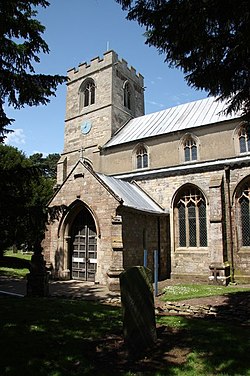Friskney
| Friskney | |
| Lincolnshire | |
|---|---|
 Church of All Saints, Friskney | |
| Location | |
| Grid reference: | TF460555 |
| Location: | 53°4’39"N, 0°10’46"E |
| Data | |
| Population: | 1,563 (2011) |
| Post town: | Boston |
| Postcode: | PE22 |
| Dialling code: | 01754 |
| Local Government | |
| Council: | East Lindsey |
Friskney is a village in Lindsey, the northern part of Lincolnshire.
The wider parish includes the hamlet of Friskney Eaudyke. The 2011 Census recorded a parish population of 1,563 in 652 households.
Contents
History
The name 'Friskney' is first attested in the Domesday Book of 1086, where it appears as Frischenei. It is recorded as Freschena circa 1115 and as Freschenei circa 1150. The name is Norse in origin, meaning 'freshwater island', though an alternative derivation, from the Old English Frescan ea ('fresh river') has been suggested..[1]
In 1885 Kelly's reported two Wesleyan chapels, one built in 1804.[2] The chapel built in 1839 is Grade II* listed.[3] It recorded that Friskney parish was a centre for brick making and the catching of shrimps and cockles. In the early part of the 19th century, much of the land was wetlands or swamp, where wildfowl were caught by use of decoy ponds.[2] One of these ponds is now a listed ancient monument.[4] The swamp was drained in the early 19th century and the land converted for arable cultivation.[2]
Parish church
The parish church, All Saints is a mediæval edifice. The original church was constructed in the late 12th century, and it had elements added up to the 15th.[5] Restoration to the chancel was carried out in 1849.
The church is a Grade I listed building[5]
During an extensive restoration in 1879, Norman and Early English Gothic architectural fragments were discovered. The lower stage of the tower, with large lancet windows, is Early English, as is the second stage. The two upper stages are 15th-century, as is the font. In the north aisle is an incised stone slab to John de Lyndewode (rector, 1374) and a mutilated effigy of a 14th-century knight, likely damaged during the iconoclasm of the Reformation.[6] During the 1879 restoration, a series of faded wall paintings were revealed between the arches of the arcades.[5][6]
About the village
Abbey Hills lies half a mile west of the church:[7] this is the site of an old religious house connected with Bolington [Bullington] Priory[2] or Bardney Abbey,.
On the western side of the village on Dickon Hill Road is the Parrot Zoo and National Parrot Sanctuary. The Sanctuary was opened in 2003.[8]
The village has a church hall, two public houses, The Anchor and The Barley Mow, and a village shop-cum-post office.
Sport and leisure
There are sports clubs for archery, bowls and cricket, and a football team.
Outside links
| ("Wikimedia Commons" has material about Friskney) |
References
- ↑ Ekwall, Eilert, The Concise Oxford Dictionary of English Place-Names. Oxford, Oxford University Press, 4th edition, 1960. p. 188 ISBN 0198691033
- ↑ 2.0 2.1 2.2 2.3 Kelly's Directory of Lincolnshire with the port of Hull 1885, pp. 398, 399
- ↑ National Heritage List 1267369: Methodist Chapel (Grade II listing)
- ↑ National Heritage List 1019098: Decoy Wood decoy pond (Scheduled ancient monument entry)
- ↑ 5.0 5.1 5.2 National Heritage List 1223280: Church of All Saints (Grade I listing)
- ↑ 6.0 6.1 Cox, J. Charles (1916) Lincolnshire pp. 130-132; Methuen & Co. Ltd
- ↑ National Heritage List 1016044: Abbey Hills moated site (Scheduled ancient monument entry)
- ↑ "Lincolnshire parrot sanctuary to get £500,000 expansion". BBC. https://www.bbc.co.uk/news/uk-england-lincolnshire-17539681. Retrieved 5 November 2015.